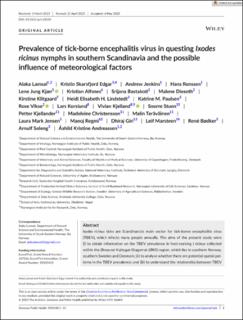| dc.identifier.citation | Lamsal, A., Edgar, K. S., Jenkins, A., Renssen, H., Kjær, L. J., Alfsnes, K., Bastakoti, S., Dieseth, M., Klitgaard, K., Lindstedt, H. E. H., Paulsen, K. M., Vikse, R., Korslund, L., Kjelland, V., Stuen, S., Kjellander, P., Christensson, M., Teräväinen, M., Jensen, L. M., Regmi, M., Giri, D., Marsteen, L., Bødker, R., Soleng, A. & Andreassen, Å. K. Prevalence of tick-borne encephalitis virus in questing Ixodes ricinus nymphs in southern Scandinavia and the possible influence of meteorological factors. Zoonoses and Public Health. | en_US |
| dc.description.abstract | Ixodes ricinus ticks are Scandinavia's main vector for tick-borne encephalitis virus (TBEV), which infects many people annually. The aims of the present study were (i) to obtain information on the TBEV prevalence in host-seeking I. ricinus collected within the Øresund-Kattegat-Skagerrak (ØKS) region, which lies in southern Norway, southern Sweden and Denmark; (ii) to analyse whether there are potential spatial patterns in the TBEV prevalence; and (iii) to understand the relationship between TBEV prevalence and meteorological factors in southern Scandinavia. Tick nymphs were collected in 2016, in southern Scandinavia, and screened for TBEV, using pools of 10 nymphs, with RT real-time PCR, and positive samples were confirmed with pyrosequencing. Spatial autocorrelation and cluster analysis was performed with Global Moran's I and SatScan to test for spatial patterns and potential local clusters of the TBEV pool prevalence at each of the 50 sites. A climatic analysis was made to correlate parameters such as minimum, mean and maximum temperature, relative humidity and saturation deficit with TBEV pool prevalence. The climatic data were acquired from the nearest meteorological stations for 2015 and 2016. This study confirms the presence of TBEV in 12 out of 30 locations in Denmark, where six were from Jutland, three from Zealand and two from Bornholm and Falster counties. In total, five out of nine sites were positive from southern Sweden. TBEV prevalence of 0.7%, 0.5% and 0.5%, in nymphs, was found at three sites along the Oslofjord (two sites) and northern Skåne region (one site), indicating a potential concern for public health. We report an overall estimated TBEV prevalence of 0.1% in questing I. ricinus nymphs in southern Scandinavia with a region-specific prevalence of 0.1% in Denmark, 0.2% in southern Sweden and 0.1% in southeastern Norway. No evidence of a spatial pattern or local clusters was found in the study region. We found a strong correlation between TBEV prevalence in ticks and relative humidity in Sweden and Norway, which might suggest that humidity has a role in maintaining TBEV prevalence in ticks. TBEV is an emerging tick-borne pathogen in southern Scandinavia, and we recommend further studies to understand the TBEV transmission potential with changing climate in Scandinavia. | en_US |

